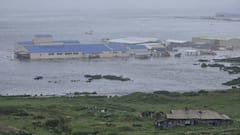India Sends 23 Scientists To Antarctica As Part Of 41st Scientific Expedition To The Continent
The 41st Expedition to Antarctica has two major programs; one is associated with the Amery Ice Shelf, while the other is related to the drilling of an ice core near Maitri research station.

New Delhi: On Monday, November 16, India successfully launched the 41st scientific expedition to Antarctica. The first batch comprises 23 scientists and support staff.
The expedition is led by Dr. Shailendra Saini, a scientist at the National Centre for Polar and Ocean Research, Shri Huidrom Nageshwar Singh, Meteorologist at the Indian Meteorological Department, and Shri Anoop Kalayi Soman, a scientist at the Indian Institute of Geomanetism. Saini is the voyage leader for the 41st expedition, while Singh and Soman are leaders at the Maitri and Bharati Stations respectively.
The Indian contingent reached the Indian Antarctic station named Maitri last week. By mid-January 2022, the Dronning Maud Land Air Network Project (DROMLAN) and the chartered ice-class vessel MV Vasiliy Golovnin will transport four more batches to Antarctica, according a statement by the Union Ministry of Earth Sciences.
The 41st Expedition Program
The 41st Expedition to Antarctica has two major programs. One is associated with the Amery Ice Shelf, while the other is related to the drilling of an ice core near Maitri research station.
As part of the first program, the Amery ice shelf at Bharati station will be explored. The Amery Ice Shelf, located on the east coast of Antarctica, is one of the largest glacier drainage basins in the world. The geological exploration mission will help determine how India and Antarctica were linked in the past, mentions the statement.
Reconnaissance surveys (extensive study of an entire area that might be used for a road or airfield) will be conducted in the ice core near Maitri, as part of the second program. Also, preparatory work for drilling of 500 metres of the ice core will be conducted to better understand the climatic conditions of the continent, westerly winds, sea-ice and greenhouse gases from a single climate archive for the past 10,000 years.
India will conduct the drilling in collaboration with the British Antarctic Survey and the Norwegian Polar Institute. The expedition will not only accomplish scientific programs but will also replenish annual supplies of food, fuel, provisions and spares for operations and maintenance of life support systems at the Maitri Research Institute and the Bharati Research Centre in Antarctica.
History Of The Indian Antarctic Program
Since 1981, the Indian Antarctic Program has completed 40 scientific expeditions. Three permanent research base stations have been established in Antarctica, namely, the Dakshin Gangotri, Maitri, and Bharati, built in 1983, 1988, and 2012 respectively.
The entire Indian Antarctic Program is managed by the National Centre for Polar and Ocean Research (NCPOR), Goa, which is an autonomous institute under the Ministry of Earth Sciences.
What Training Did The Indian Contingent Undergo?
Before reaching Antarctica, the Indian contingent went through a strict medical examination at the All India Institute of Medical Sciences, New Delhi.
The crew completed a training for acclimatisation to and survival in snow ice at the Mountaineering and Skiing Institute, Indo-Tibetan Border Police Auli, Uttarakhand. The contingent also completed a stringent sanitary protocol including a quarantine for 14 days at Cape Town, South Africa, mentions the statement.
The crew is expected to return to Cape Town in late March or in early April next year, along with the winter over team of the previous expedition. The term “winter over” refers to the people who stay in Antarctica over the winter season. The winter over team of the current expedition, comprising 48 members, will remain in Antarctica.






































